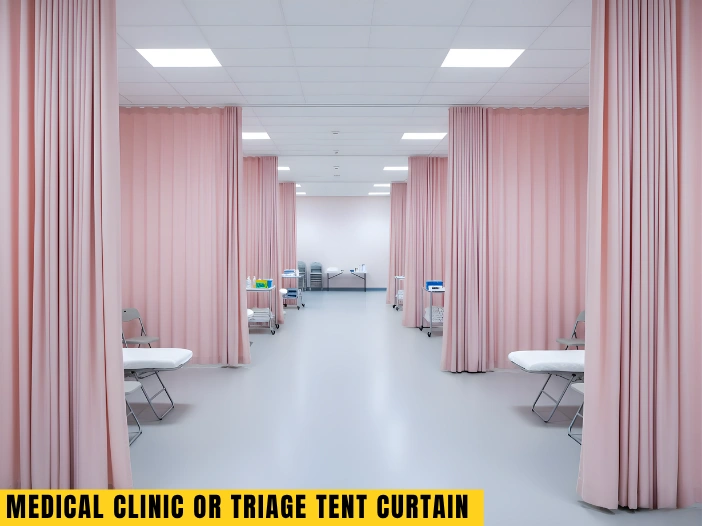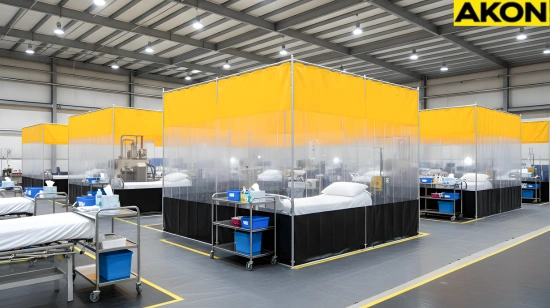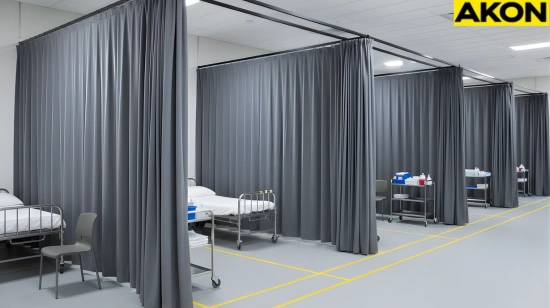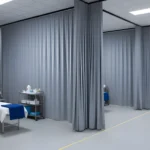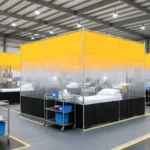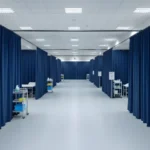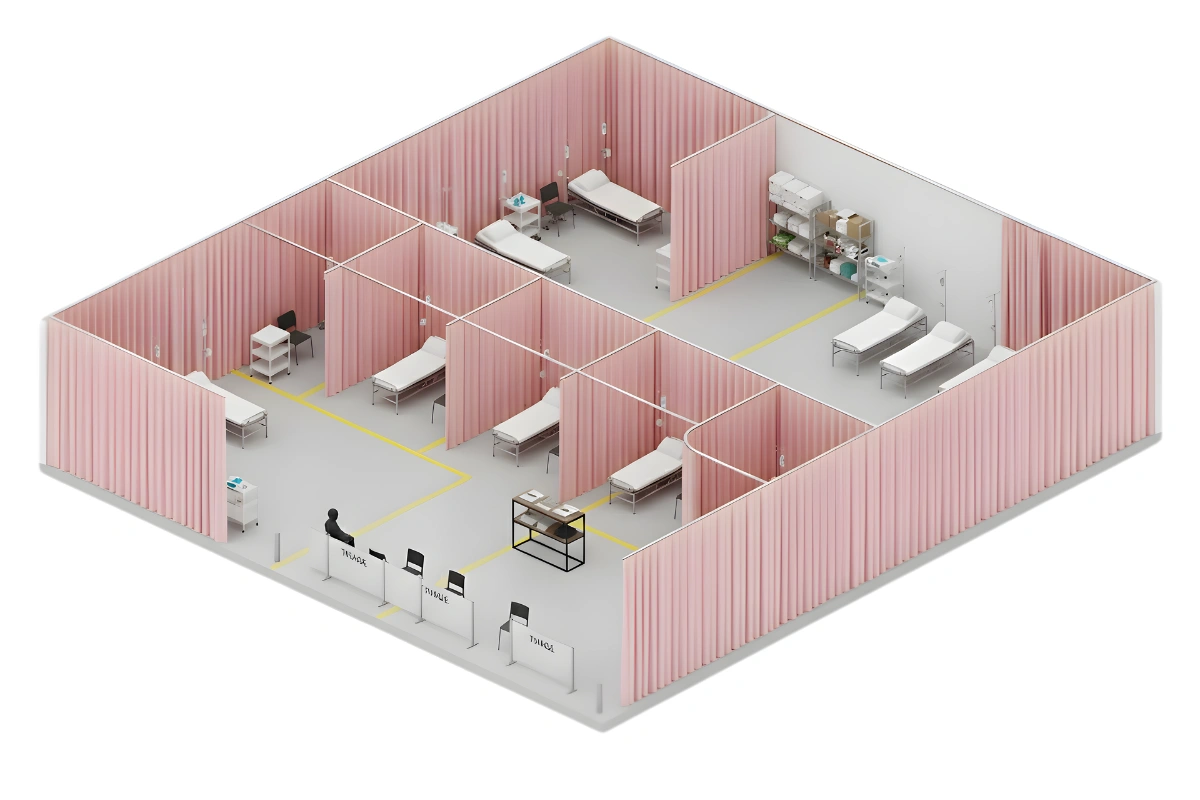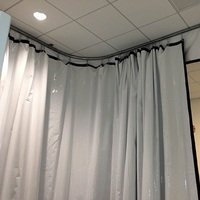Medical Clinic or Triage Tent Curtains
Curtain walls are modular vinyl panels that create temporary treatment zones in emergency overflow clinics or triage tents. This article guides disaster readiness coordinators and NGOs through common challenges, practical setup tips, key features, product options, and FAQs. It shows how to deploy safe, flexible, and efficient medical spaces during sudden patient surges.
The Key Challenges Facing Emergency Overflow Clinics & Triage Tents
Emergency overflow clinics and triage tents face unique challenges during sudden patient surges. Coordinators and NGO teams must quickly create functional medical zones while keeping staff and patients safe. Achieving efficiency requires balancing operational needs with environmental constraints. This section highlights the main challenges that can impact patient flow, privacy, infection control, and overall care quality in temporary or converted medical spaces.
Operational Challenges During Surge Events
High patient volume can quickly overwhelm temporary clinics. Coordinators must establish functional treatment zones without delaying care. Efficient patient flow is essential to avoid bottlenecks and confusion. Rapidly changing needs require adaptable layouts. Teams must ensure staff can navigate the space safely and perform duties effectively.
Clear zone delineation, quick access to supplies, and fast deployment of partitions are critical for smooth operations during high-pressure situations. Modular systems help coordinators maintain efficiency even under unpredictable conditions.
Environmental and Safety Constraints
Temporary clinics often face physical limitations such as limited space, temperature control, and ventilation challenges. Maintaining patient privacy and enforcing infection control in crowded environments adds complexity. Coordinators must ensure airflow is adequate and treatment areas are properly separated.
Limited resources and tent-based setups make addressing these constraints difficult without flexible solutions. Modular and scalable systems allow teams to overcome environmental challenges while protecting patients and staff, ensuring safe, efficient care during emergencies or humanitarian response operations.
How Curtain Wall Systems Solve These Challenges
Curtain wall systems help emergency clinics and triage tents overcome operational and environmental hurdles while keeping patient care efficient and safe. They provide temporary, well-defined treatment zones that can be set up quickly and adjusted as needs change.
• Rapid Deployment: Temporary treatment zones can be established in hours, allowing staff to start care immediately without waiting for permanent construction. This speed is critical during sudden patient surges or disaster response scenarios.
• Enhanced Safety and Privacy: Durable, fire-rated vinyl panels provide clear separation between zones, protecting patient privacy and helping limit cross-contamination. Coordinators can ensure treatment areas meet safety and hygiene standards with minimal setup.
• Adaptable Layouts: Modular designs allow coordinators and NGOs to reconfigure spaces on the fly, accommodating fluctuating patient volumes or changing operational needs. This flexibility ensures the clinic can quickly adjust to evolving conditions without interrupting care.
Fast Setup
Quick-deploy designs let staff establish treatment zones within hours, ensuring urgent patient care can begin immediately.
Privacy & Safety
Durable, fire-rated vinyl panels provide essential privacy for patients while reducing the risk of cross-contamination between zones.
Flexible Space Control
Modular panels allow coordinators to reconfigure layouts instantly, adapting to fluctuating patient volume or evolving clinic needs.
Material Options

Vinyl
In areas where getting the curtain dirty is a concern we have the 18oz Vinyl curtains. Its slick surface makes it easy to clean and it is resistant to water spray. Unlike the fabric materials its surface is more reflective and shiny. This is the workhorse material that is made for less than ideal conditions. 100% Visual blackout, 90% Light blackout. $$
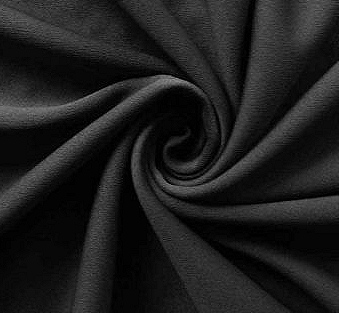
Fabric | Poly Stretch
Poly Stretch 6oz is a soft material commonly used in many commercial and industrial photo applications. It’s a two-way stretch fabric with zero, to minimal wrinkle and it has a flat matte finish. It is commonly used to create backdrop walls for photography of large products like automobiles. 75% Visual blackout, 50% Light blackout. $$

Fabric | Premium Velour
This luxurious 14oz fabric is ideal for stage backdrops, dividing a space or creating a high-end look with fabric. It's inherently flame resistant, lightweight and washable. It's the ideal fabric for commercial curtains that need to look great at a reasonable price. 100% Visual blackout, 90% Light blackout. $$$
Material Options

18 oz Reinforced Vinyl (standard)
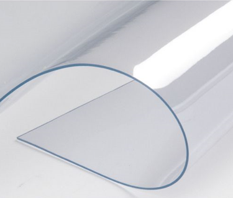
20 mil Clear PVC For Clarity
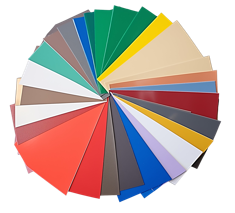
Available in Multiple Colors
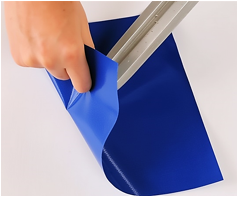
Strong Materials
What to Look For When Choosing a Curtain Wall System
Selecting the right curtain wall system is critical for creating effective treatment zones in emergency overflow clinics or triage tents. Coordinators and NGOs must consider factors that affect safety, workflow, and adaptability. The right system ensures easy deployment, smooth patient flow, and reliable performance under high-pressure conditions.
| Feature | Why it Matters | Typical Specification |
|---|---|---|
| Material & Fire Rating | Ensures safety, hygiene compliance, and durability in emergency or temporary clinics | 18 oz vinyl, fire-retardant polyester-reinforced |
| Size & Customization | Accommodates different clinic spaces, tents, or converted facilities | Custom width and height to match available space |
| Track or Mounting Hardware | Determines ease of installation, stability, and reconfiguration | Ceiling-mounted track or free-standing frame |
| Access/Visibility Features | Supports workflow, monitoring, and patient observation | Clear-view panels or roll-up sections |
| Cleaning & Maintenance | Ensures hygiene in high-traffic emergency settings | Smooth vinyl surfaces with minimal seams |
| Cost & Lead Time | Critical for rapid deployment and budget planning during emergencies | Quick-ship options, low installation cost |
When planning a setup, measure the available space carefully and decide whether a ceiling-mounted or free-standing track is most practical for your facility or tent. Panels should be easy to clean and disinfect to maintain infection control. Budgeting, resource allocation, and timeline planning are essential to ensure the system can be deployed rapidly without compromising patient safety or staff efficiency.
Top Curtain Wall Options for NGO and Disaster Response Setups
For disaster-response coordinators and NGOs, selecting the right curtain wall system ensures efficient, safe, and flexible treatment zones. These three products combine durability, rapid deployment, and adaptability to meet emergency clinic and triage tent needs.
Insulated Curtain Wall
The insulated curtain wall is designed to maintain stable temperature zones, which is critical for patient comfort and environmental control in temporary medical spaces. Its modular design allows fast deployment in tents, converted halls, or other emergency facilities.
• Thermally insulated panels help regulate airflow and temperature.
• Supports rapid setup for multiple treatment zones.
• Provides patient privacy while maintaining clear separation between areas.
• Fire-rated and durable for repeated use in emergency scenarios.
Fabric | Poly Stretch
This polyester stretch fabric system is highly adaptable, making it suitable for a wide range of temporary clinic layouts. It combines flexibility with clean aesthetics and moderate acoustic control, enhancing workflow and patient comfort.
• Flexible polyester fabric adjusts to varied layouts and spaces.
• Provides moderate sound absorption to reduce distractions.
• Quick to install and reconfigure as patient flow changes.
• Fire-rated and easy to clean between shifts or deployments.
Fabric | Premium Velour
The premium velour system is ideal for semi-permanent or multi-day emergency clinics where patient comfort and quiet environments are important. Its soft, sound-absorbing panels provide privacy while remaining durable and easy to maintain.
• High-end velour fabric improves privacy and indoor comfort.
• Absorbs sound, reducing noise in busy temporary clinics.
• Suitable for multi-day NGO setups or semi-permanent facilities.
• Fire-rated, washable, and reusable for future emergency deployments.
Frequently Asked Questions
FAQs: Emergency Clinic Curtain Wall Systems
How quickly can Insulated Curtain Wall panels be set up in a triage tent?
These panels can be installed in 2–3 hours, allowing coordinators to establish treatment zones quickly. Custom widths and track hardware can be requested to fit tents or converted halls efficiently.
Can Fabric | Poly-Stretch systems be installed without professional help?
Yes, trained staff or volunteers can assemble these modular panels with minimal guidance, making them ideal for NGO deployments or rapid emergency setups.
Are Premium Velour partitions adjustable after installation?
Yes, these modular systems allow easy reconfiguration as patient flow changes or zones need adjustment, ensuring efficient use of space.
Do curtain walls require special tools for assembly?
Basic tools are sufficient. Ceiling-mounted or free-standing track hardware is included, simplifying setup in tents, gyms, or temporary halls.
Are these systems safe for high-traffic emergency clinics?
Yes, Insulated Curtain Wall, Poly-Stretch, and Premium Velour panels are fire-rated, durable, and tested for high-traffic deployment in temporary medical setups.
Do they meet infection control standards?
Yes, all panels feature smooth, easy-to-clean surfaces to support hygiene protocols and limit cross-contamination between treatment zones.
How do these curtain walls protect patient privacy?
The panels create clear physical separation between zones. Premium Velour and Insulated panels enhance privacy, even in crowded tents or multi-use halls.
Can these systems help manage airflow and ventilation?
Yes, modular layouts allow coordinators to optimize airflow while maintaining separation of intake, treatment, and observation areas.
Can these curtain walls be reused after an emergency deployment?
Absolutely. Insulated, Poly-Stretch, and Premium Velour panels are built for multiple deployments, making them cost-effective for NGOs.
How durable are the panels for frequent use?
High-quality vinyl and fabric materials withstand repeated setup, takedown, and transport, ensuring long-term reliability.
Are they resistant to tearing or damage?
Yes, reinforced construction in each system provides durability in high-traffic, temporary medical environments.
Can these panels be used outdoors in tents?
Yes, provided they are properly anchored and protected from extreme weather. Modular design supports semi-outdoor deployment.
Can Insulated Curtain Wall panels be customized to fit unique layouts?
Yes, panels can be cut or ordered to width, and track systems can be configured to match tents, gyms, or halls.
Are there options for different panel heights?
Yes, custom heights are available for all three systems to fit your clinic or tent dimensions.
Do panels support accessories like windows or roll-up doors?
Yes, optional clear panels or roll-up sections can be added for patient monitoring and workflow efficiency.
Can different panel types be mixed in one setup?
Yes, coordinators can combine Insulated, Poly-Stretch, and Premium Velour panels to meet specific privacy, comfort, and environmental needs.
How does the cost compare to building temporary walls or partitions?
These curtain walls are generally more cost-effective and faster to deploy than permanent construction or other temporary partitions.
Do they require ongoing maintenance or replacement parts?
Routine cleaning is sufficient. Replacement panels or hardware are available if damage occurs during use.
How much space is needed for storage?
Panels can be stacked or rolled compactly when not in use. Storage depends on the number and type of panels deployed.
Can NGOs pre-order panels for future emergencies?
Yes, planning ahead ensures panels are on hand for rapid deployment during patient surges or disaster relief operations.
Planning Your Emergency Clinic Deployment
Curtain wall systems provide disaster readiness coordinators and NGOs with a practical, flexible, and efficient solution for emergency overflow clinics and triage tents. Their modular design and rapid deployment capabilities make it easy to create safe, private treatment zones while managing patient surges effectively. To stay prepared, coordinators should pre-plan layouts, select the right panel systems, and secure track hardware in advance. For quick action during emergencies, request a consultation, obtain a quote, or explore custom options to ensure your space is ready for rapid deployment.

